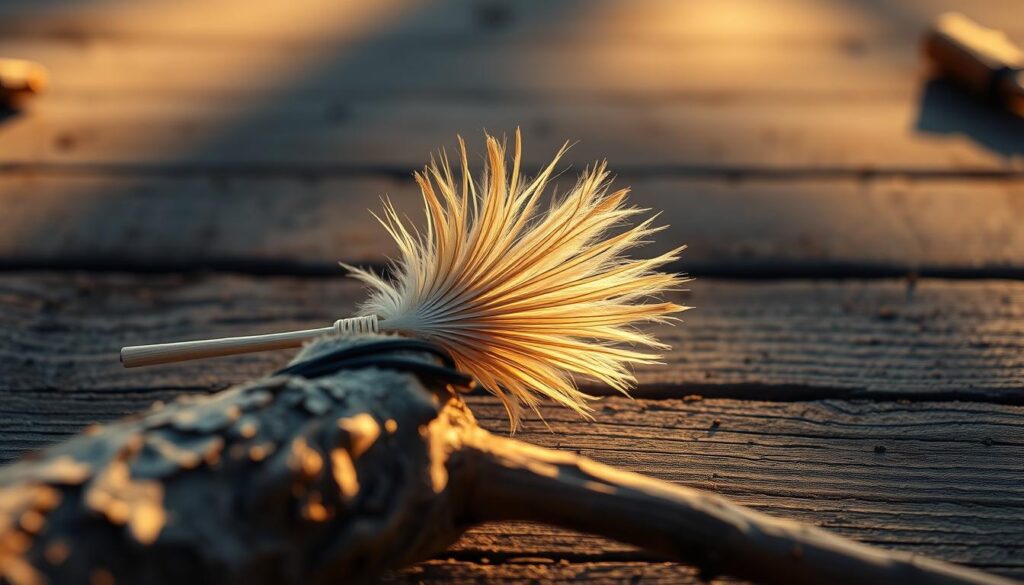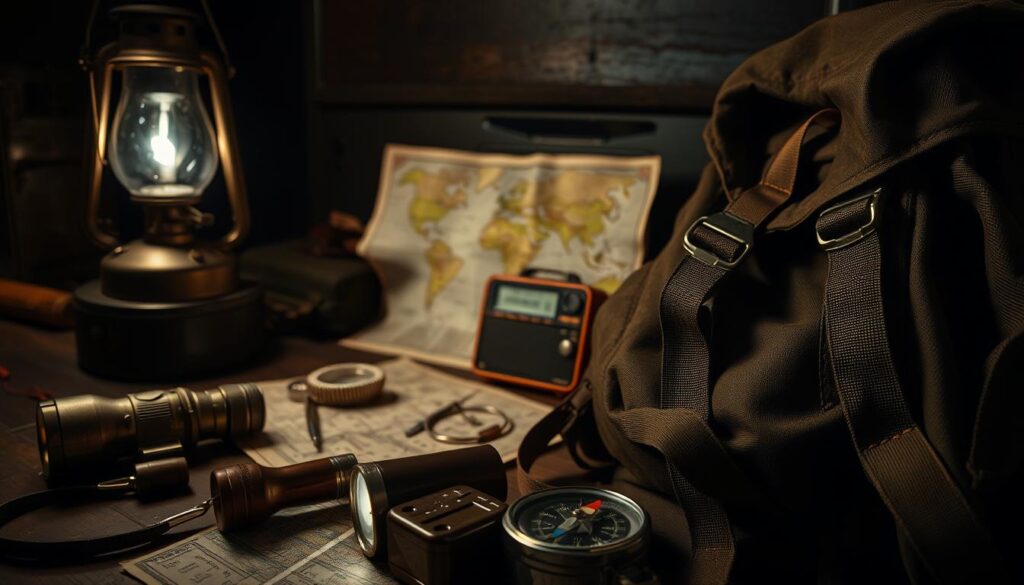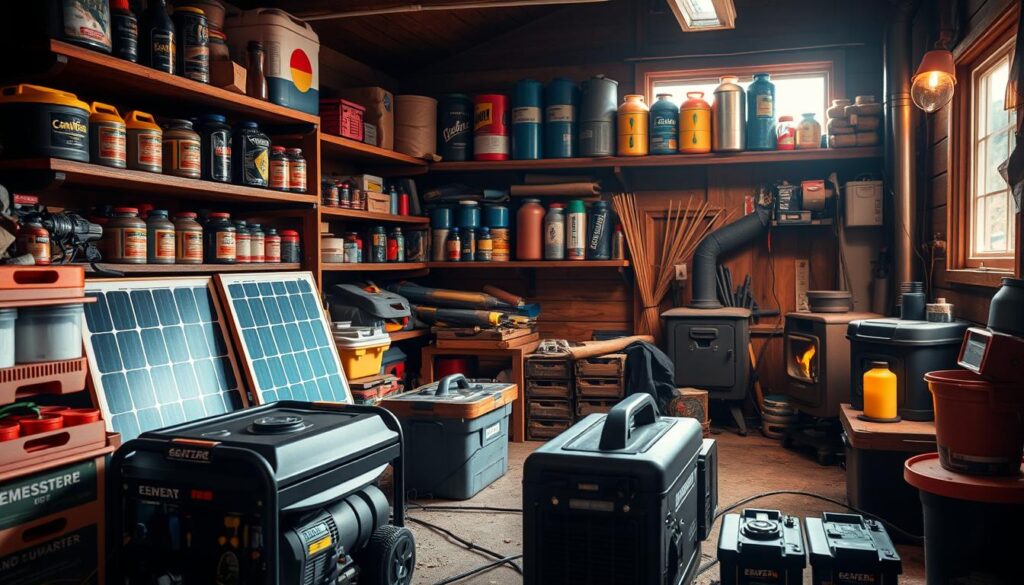I’ve always been drawn to the simplicity and power of a feather stick as a fire starting tool. In the wild, starting a fire can be critical. A feather stick is a reliable way to do this. Making a feather stick takes practice, patience, and the right materials.
As a fan of bushcraft and outdoor adventures, I’ve learned that making a feather stick is both useful and calming. You need to pick the right wood, like dead, dry wood from trees like pine, willow, or cedar. Then, use a knife to shave off thin strips, making a fluffy surface that lights up easily.
Key Takeaways
- Crafting a feather stick is a valuable skill for wilderness survival and bushcraft.
- The right materials, such as dead, dry, and standing wood, are essential for creating a feather stick.
- Pine, willow, and cedar are among the types of wood suitable for making feather sticks.
- A sharp knife and proper technique are key for making a feather stick.
- Feather sticks are highly effective for starting fires in tough outdoor conditions.
What is a Feather Stick and Why Use It?
When you go into the wilderness, knowing about feather sticks is key. A feather stick, or feather stave, is a piece of wood shaved to make fluffy material. It’s perfect for starting a fire.
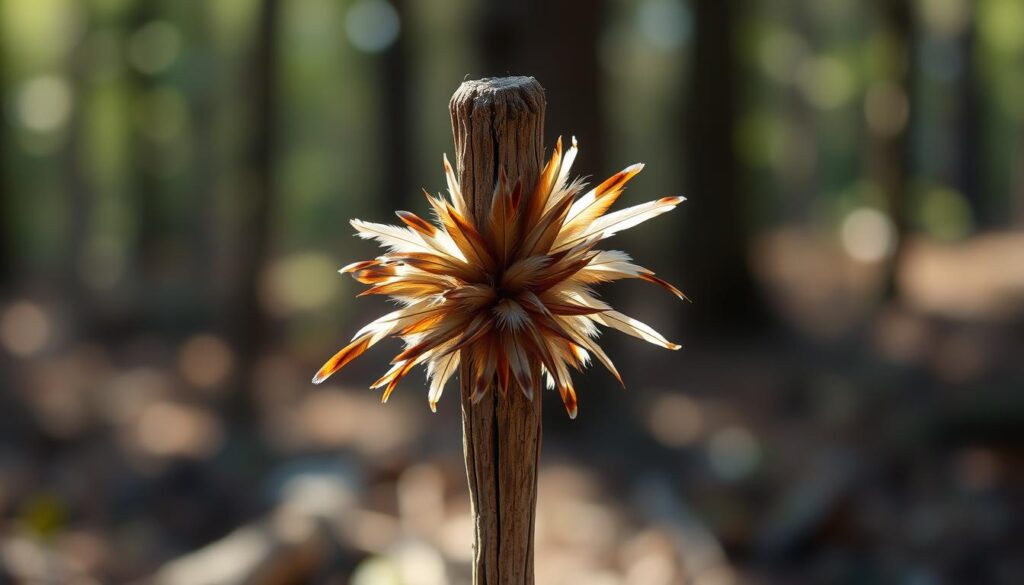
The main job of a feather stick is to help start a fire. It keeps the shavings on the stick, making them easy to carry and use. This is super helpful in wilderness survival situations where starting a fire is hard.
Understanding the Purpose of Feather Sticks
Feather sticks are great for starting fires because they offer a controlled kindling source. The shavings are fine and dry, so they light up easily, even when it’s damp or wet.
Benefits of Crafting Feather Sticks
Making feather sticks has many advantages. They give you a neat, protected kindling source. This skill is very useful in bushcraft and outdoor training, where starting a fire is a must.
Common Uses in Outdoor Skills
Feather sticks are often used in outdoor skills and wilderness survival techniques. They help teach people how to start a fire well and efficiently. This skill is vital for survival and comfort outdoors.
Tools and Materials Needed for Crafting
Before starting to make a feather stick, you need to gather the right tools and materials. Crafting a feather stick is key in outdoor skills training. It helps start a fire when you’re in a survival situation.
Essential Tools for Making a Feather Stick
You’ll need a sharp knife first. A sharp knife makes precise cuts and is safer than a dull one. Also, a batoning stick or similar tool is needed. It helps apply force without harming the knife.
Recommended Types of Wood
The wood type for a feather stick matters a lot. Pine, willow, cedar, and sweet chestnut are top choices. These woods are soft and easy to shave into fine curls.
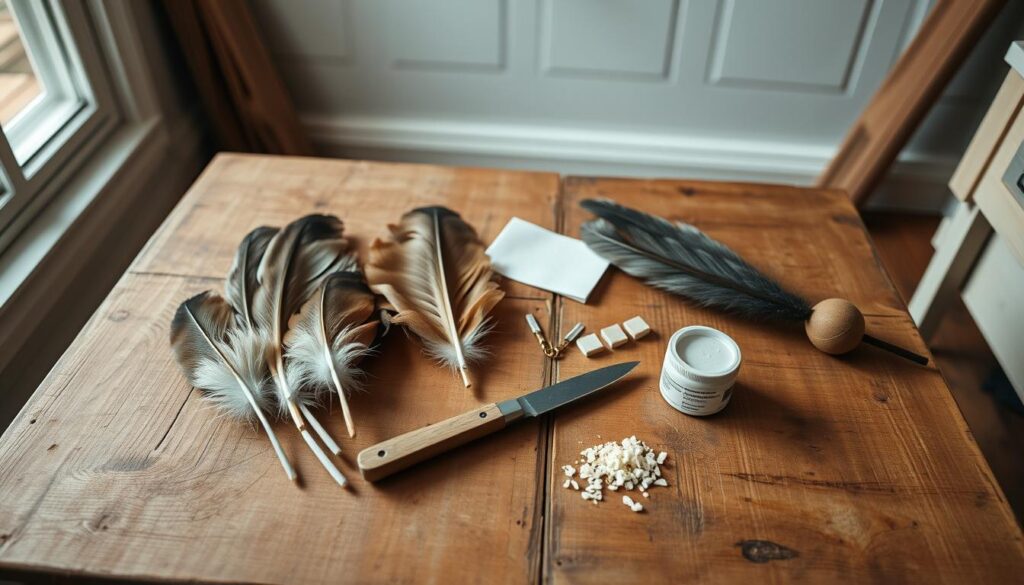
Safety Gear I Use While Crafting
Don’t forget about safety when making a feather stick. I always wear gloves to protect my hands from cuts. I also use a cutting board for a stable surface. These steps help avoid injuries.
With the right tools and materials, crafting a feather stick is safe and effective. It boosts your outdoor skills and is useful in survival situations.
Step1: Selecting the Right Wood
Choosing the right wood is key when making a feather stick. It affects the quality and how well it works as natural tinder.
Identifying Suitable Wood Types
Good wood for feather sticks is dead, dry, and standing. It should be free from rot and too much moisture. This ensures it ignites and burns well.
Joe Robinet, a well-known outdoorsman, said, “The quality of your tinder is as good as the wood you’ve chosen.” This shows how important picking the right wood is.
Importance of Fresh, Dry Wood
Fresh, dry wood is vital for making effective feather sticks. Wood that’s too wet or rotten won’t work well. It’s hard to light and keep a fire going.
- Dry wood ignites more easily.
- Fresh wood ensures a cleaner burn.
- Avoid wood with signs of decay.
How to Find Wood in the Wild
To find good wood in the wild, look for standing trees with few knots. Dead branches or sticks on the ground work too, if they’re dry and not rotten.
“The best tinder is often found in the most unexpected places, like the dry branches of a standing tree.” –
Understanding what wood is best and where to find it can boost your feather stick making skills.
Step2: Preparing Your Work Area
Creating a safe and efficient workspace is key in primitive fire making. A tidy area boosts productivity and lowers accident risks.
Setting Up a Safe Workspace
To ensure a safe area, clear a flat space of debris or flammable stuff. A cutting board can make a great base for your feather stick. This simple move cuts down injury risks and makes crafting better.
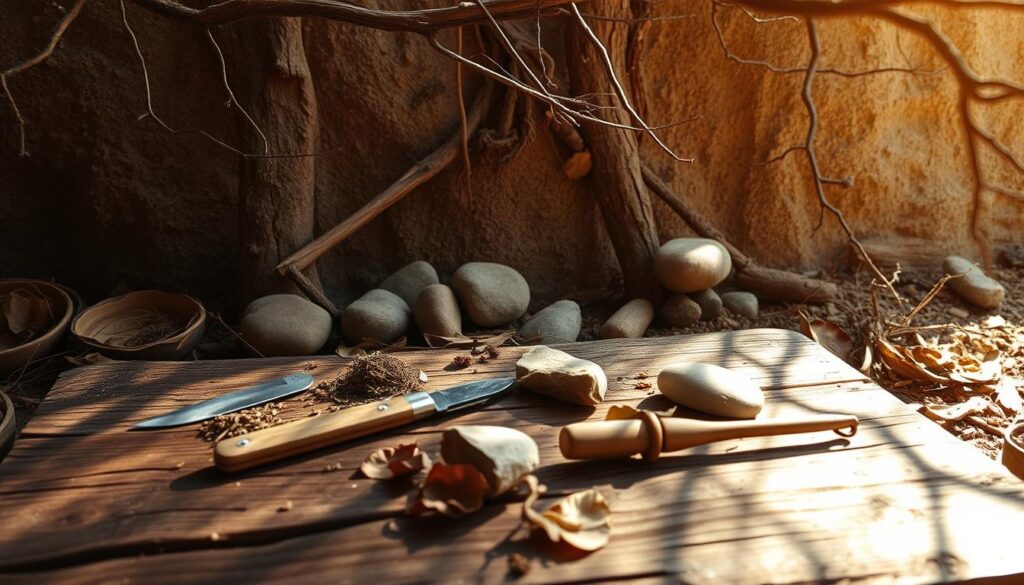
Organizing Tools and Materials
Having your tools and materials ready is essential for efficiency. Here are some tips to stay organized:
- Place your often-used tools, like knives and cutting boards, where you can easily reach them.
- Store your materials in a container or pouch to keep them organized and prevent loss.
- Label your tools and materials if needed, so you can quickly find what you need.
Tips for Reducing Distractions
It’s important to focus on your task without distractions. Here are some ways to do that:
- Find a quiet spot away from distractions.
- Limit your use of electronic devices or turn them off.
- Set a specific time for your crafting to keep a steady pace.
By following these tips, you can make a space that helps you concentrate better. This will improve your primitive fire making skills.
Step3: Shaping the Stick
Now, I’m focusing on shaping the stick. This step is key to making a feather stick that works well and is safe. It’s all about making it functional and safe.
To shape the stick, I shave and plane the surface with a knife. Maintaining a firm grip and control over the knife is vital. This helps avoid accidents and gets a smooth finish.
Techniques for Shaping the Craft
There are a few ways to shape the stick. One method is using long, smooth strokes to remove bark and plane the surface. It’s important to work slowly and carefully to get the right shape.
- Use a sharp knife to make clean cuts.
- Apply gentle pressure to avoid applying too much pressure, which can cause the stick to break.
- Work in a well-lit area to ensure visibility.
Importance of Grip and Control
Having a firm grip and control over the knife is key for safety and effectiveness. A good grip helps in making precise cuts and reduces the risk of accidents.
Common Mistakes to Avoid
Some common mistakes to avoid when shaping the stick include applying too much pressure, using a dull knife, and not working in a stable environment. Knowing these pitfalls helps in making a well-crafted feather stick.
Step4: Creating the Feather Cuts
Making the feather cuts is a key step in making a feather stick. It needs precision and patience. The quality of these cuts is very important for the feather stick’s performance as a fire starting tool.
Efficient Feather Cuts
To make good feather cuts, you need a sharp knife. A dull knife can cause uneven cuts and accidents. Keeping a consistent angle is also important for the feather stick’s effectiveness.
- Use a sharp knife to make clean cuts.
- Maintain a consistent angle for each cut.
- Apply gentle pressure to avoid breaking the wood.
Techniques for Evenly Spaced Cuts
Making evenly spaced cuts can be hard. But, using a guide or template can help a lot. This method ensures uniformity, which is essential for the feather stick’s best performance.
- Create or obtain a guide that can be used to mark the stick.
- Mark the stick where you intend to make cuts.
- Carefully make cuts along the marked lines.
Avoiding Breakage During Cutting
Breakage during cutting is frustrating and wasteful. To prevent this, use gentle pressure and keep your knife sharp. A sharp knife cuts through wood smoothly, lowering the chance of breakage.
By using these techniques and tips, you can make the feather cuts on your stick. This will make it a dependable fire starting tool. Remember, practice makes perfect, so don’t get discouraged by your first tries.
Step5: Testing the Feather Stick's Functionality
The true test of a feather stick is its ability to ignite easily. This is a key part of wilderness survival technique. It shows if the crafting was successful.
Methods to Test the Feather Stick
To test the feather stick, I try to light it with my favorite method. This could be with a ferrocerium rod, a lighter, or by friction. How easily it ignites shows the quality of the cuts.
If it ignites easily, the cuts are likely good. But if it’s hard to light, I might need to change the cuts or the stick’s size.
Assessing the Effectiveness of Your Cuts
The quality of the cuts is seen in how well the feather stick ignites and burns. Evenly spaced cuts that are just right are best. They help the stick work well.
If the stick doesn’t light up as hoped, check the cuts. Are they too far apart or too close? Changing the cut spacing and depth can help a lot.
Adjusting the Stick for Optimal Performance
If the first test doesn’t work, you can make changes. You might need to fine-tune the cuts for better balance. The aim is to make a reliable bushcraft fire starter for outdoor use.
By testing and tweaking the feather stick, I make sure it’s right for me. This process not only proves the crafting was worth it. It also teaches me what makes a good feather stick.
Additional Tips for Success
Making feather sticks is more than just following steps. It’s about getting better with practice and patience. As you keep working on your outdoor skills, you’ll see how certain practices help a lot.
Practice Techniques I Recommend
Improving at feather stick crafting comes from regular practice. Set aside time to make feather sticks often. Try different woods and work in various conditions. This will teach you how different things affect your craft.
For example, trying different woods can show you how they change your effective natural tinder making. Knowing this is key when you need to survive outdoors.
Learning from Mistakes
Mistakes happen when you’re learning, and feather stick crafting is no different. Instead of getting upset, see mistakes as chances to learn and get better. Figure out what went wrong and change your method.
If your feather sticks won’t light, it might be because the wood is too wet or the cuts are too coarse. Spotting the problem lets you fix it and do better next time.
Seeking Feedback from Others
Getting feedback from those who know outdoor skills is also helpful. Look for communities or mentors. They can share tips and insights you might not think of.
Don’t hesitate to show your work and ask for honest feedback. This can really help you get better. Also, watching others make feather sticks can inspire new ideas and methods for you.
Closing Thoughts on Crafting Feather Sticks
Making feather sticks has been rewarding for me. It has improved my outdoor skills and my bond with nature. This simple method has taught me the value of being self-sufficient outdoors.
Looking back, I see that making feather sticks is more than just a tool. It’s a skill that connects me to nature. It takes patience, focus, and a desire to learn and improve.
The joy of mastering outdoor skills like feather stick carving and fire making is huge. It gives me a sense of pride and confidence. I urge you to try making feather sticks and discover primitive skills. With time and effort, you’ll gain a valuable skill that makes outdoor adventures better and builds self-reliance.
FAQ
What is a feather stick and its purpose?
A feather stick is a tool for starting fires outdoors. It acts as kindling for fire starting.
What are the benefits of crafting feather sticks?
Crafting feather sticks keeps shavings attached. This makes starting a fire easier.
What tools are needed to craft a feather stick?
You’ll need a sharp knife for crafting a feather stick. Learning batoning is also key.
What type of wood is recommended for making feather sticks?
Use fresh, dry wood for feather sticks. Look for upright trees with few knots.
How do I prepare my work area for crafting feather sticks?
Set up a safe workspace for crafting feather sticks. Organize your tools and materials. Try to reduce distractions.
What are the techniques for shaping the stick for a feather stick?
To shape the stick, shave and plane it with a knife. Keep a firm grip and control.
How do I create the feather cuts on the stick?
For feather cuts, use a sharp knife and a guide. Make cuts evenly and avoid breakage.
How do I test the functionality of my feather stick?
To test your feather stick, try to light it. Check if your cuts work well. Adjust the stick for better performance.
What are some additional tips for achieving success in crafting feather sticks?
Practice your technique to get better. Learn from mistakes. Seek feedback to improve.
Why is practicing the technique of crafting feather sticks important?
Practicing makes you more skilled and confident. It helps you craft feather sticks better.

